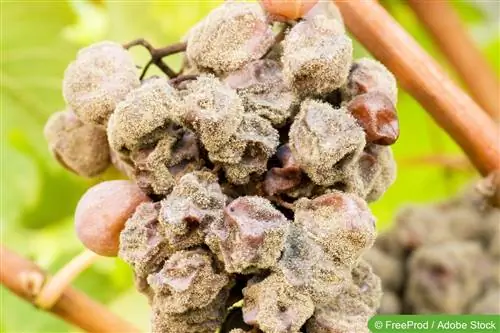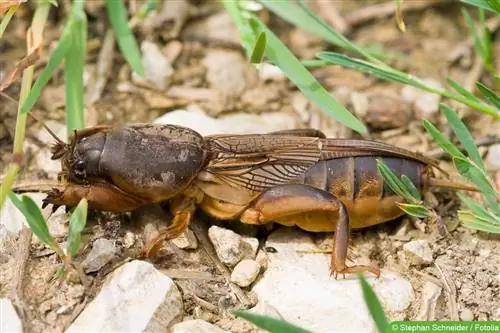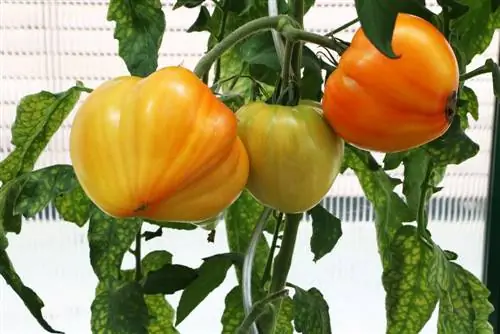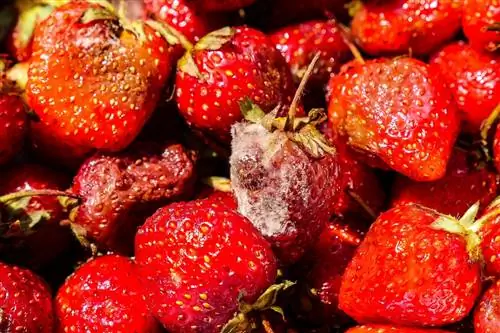- Author admin [email protected].
- Public 2023-12-17 03:39.
- Last modified 2025-01-24 12:45.
Unsightly things keep appearing in the garden and on the yard that you wouldn't want to have. Gray mold is one of these unpleasant things. This is a noble rot fungus, also known as gray rot, which particularly affects grapes, along with many other plants. Local gardeners also often find it on strawberries. The damage caused by gray mold is enormous, crops are extremely weakened and yields are significantly reduced.
When does gray mold have to be controlled in the garden?
Gray mold rot is caused by the mold Botrytis cinerea, a fungus that has developed a wide range of food sources: it is the only parasite in the genus that can feed on over 235 host plants. When the fungus covers a plant with its dusty fungal turf, it stimulates what is known as apoptosis in the cells of the affected parts of the plant. This is a kind of suicide program for the cells that causes the metabolism of a cell to react in a way that causes the cell to die. The plant tissue progressively breaks down and begins to rot.
The fungus finds the best conditions at temperatures of 22 to 25 degrees, but it also likes heat up to 35 degrees, especially if the area is nice and humid. In summer there are therefore high concentrations of Botrytis spores in the air; sometimes 70% of the mold spores carried in the air are Botrytis spores. That's why vegetables and fruits are very often attacked by botrytis in summer. This mold particularly likes all soft vegetables and fruits with a high water content. So in addition to the grapes and strawberries already mentioned, there are also cucumbers and tomatoes, cabbage and lettuce and all soft and fleshy stems, leaves and flowers.
Once landed on the plant, the mold grows extremely quickly in good conditions; it can e.g. B. cover a whole fruit. If the infected plant has been destroyed or combated, mycelia can survive at the site of the infection, also as so-called sclerotia, an almost indestructible permanent form of the fungus. They then produce new spores as soon as the temperatures become a little more spring-like, which then damage the newly planted plants in this area and continue to migrate, carried by water and wind. That's why gray mold should be taken seriously as a plant pest; it can cause a lot of damage, especially in monocultures.
Prevention of gray mold
Your garden soil and your plants will be able to defend themselves much better against an infestation with gray mold (and other fungi) if you pay attention to natural and he althy soil life, do not have any garden soil lying unprotected in your garden and your plants plant in mixed cultures. Garlic e.g. B. don't like the Botrytis spores at all, and many soil organisms such as springtails even multiply to form small disaster-prevention groups if there are too many fungal spores nearby.
First aid against Botrytis
If you detect the fungal infection very early, you can perhaps avoid complete infection of the plant and the soil, because cell death through apoptosis only ever damages the affected cell, the neighboring tissue remains intact. However, you would then have to act very quickly to prevent the fungus from spreading. You should then use the
Remove affected parts, dead plant parts, mold-covered leaves and stems, fruits and buds. If you catch all affected parts of the plant, your plant will continue to grow normally and he althily. It is best to carefully place the removed parts of the plant immediately into a plastic bag, if possible without causing spores to swirl through the air. Either this (tight) bag then ends up well sealed in the trash or you burn the remains; under no circumstances should they end up in the compost.
If houseplants are infested with gray mold, quarantining the plants that have just been freed from the fungus by hand can be helpful, if necessary using a fleece to keep any new spores that may appear on these plants. A temporary significant reduction in air humidity could also put an end to individual remaining spores.
Plant protection products against gray mold
If these control measures were not successful, there are a number of plant protection products against gray mold that are also approved for use in home and allotment gardens:
These products contain either cyprodinil combined with fludioxonil, systemic fungicides such as the agent “Switch” and the strawberry spray “Botrysan”, or fenhexamid, a not very toxic but critical fungicide for water. Fenhexamide is contained in “Teldor” and “Bayer Garten Obst-Mushroom-Free Teldor”.
These products are approved for specific places of use and for specific forms and quantities of use for various types of fruit and ornamental plants. If these special application instructions and prescribed waiting times are adhered to, the consumption of the fruits from the treated plants should be harmless.
How do you recognize gray mold?
The signs of infestation vary greatly. They start with rotting tubers, go through a visible gray fungal lawn and rotten flower bases and end with mouse-gray looking fruits and speckled flowers.
Since you don't want to accept this damage, you should do something about it. The first cause of mold must first be combated, namely moisture. All parts of the plant must be dried and watering should be stopped.
It is also necessary to remove the affected parts of the plant, as this will prevent further spread. For trees, for example, you should remove leaves and some branches so that the air can circulate better. Moss or weeds around the damaged plants should also be removed so that there is no longer any water storage left.
Afterwards, it is of course important that the crops receive their nutrients and fertilizers in exactly the amount that they need them. However, over-fertilization should be avoided. Humus soil and precise irrigation are also important.
Of course, gardening stores also have preparations that will get rid of gray mold. Here you should make sure that you do not harm the environment with these products, but rather help the plants. The best way to do this is to ask a gardener or a specialist in the garden trade. A very precise dosage of these agents must be observed so that the effects of mold and moisture are not reversed.
Once you have freed your flowers or crops from gray mold, you should continue to make sure that there is not too much moisture, because moisture promotes the development of types of mold. If you give your plants exactly what they need, you will enjoy them a lot. Even if illnesses occur, you can quickly get them under control again.






